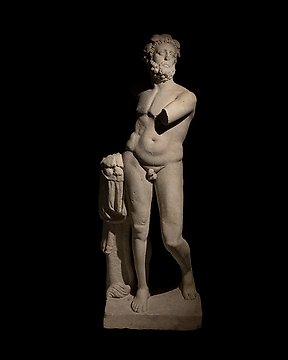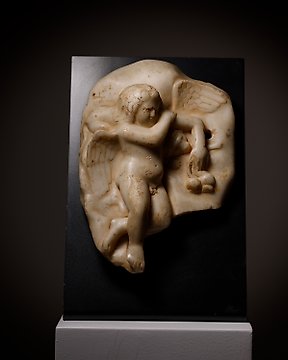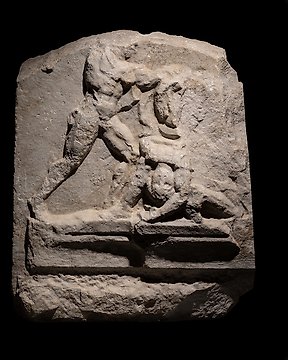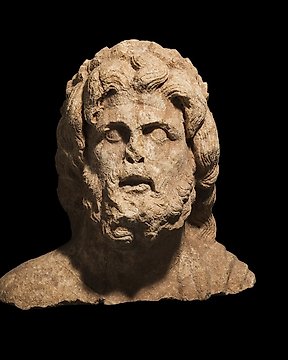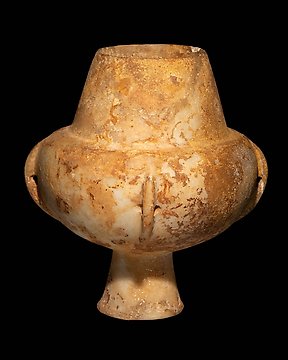All OK and with very fast shipping.
Übersetzung ansehenRömisches Reich Alabaster Kopf des Serapis. 1. - 2. Jahrhundert n. Chr. 9,5 cm H. Spanische Exportlizenz
Nr. 84870985
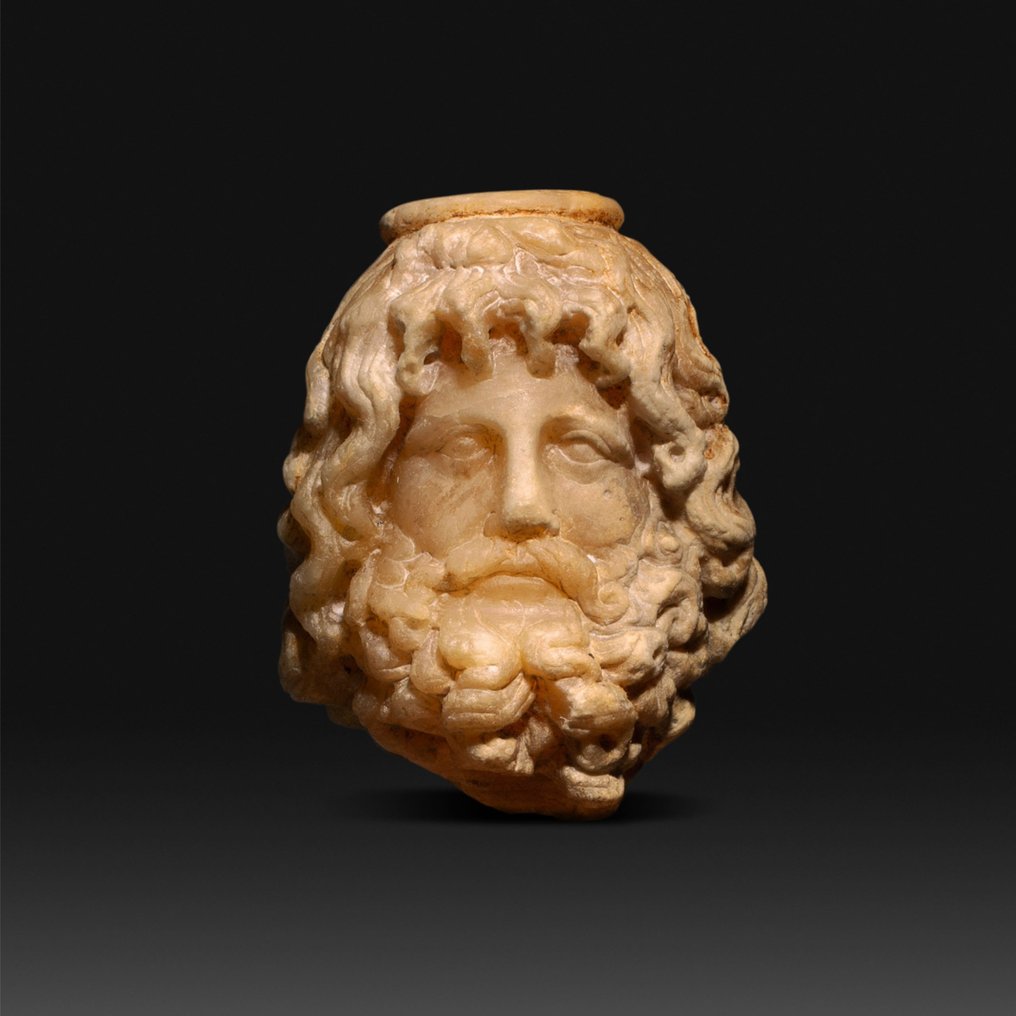
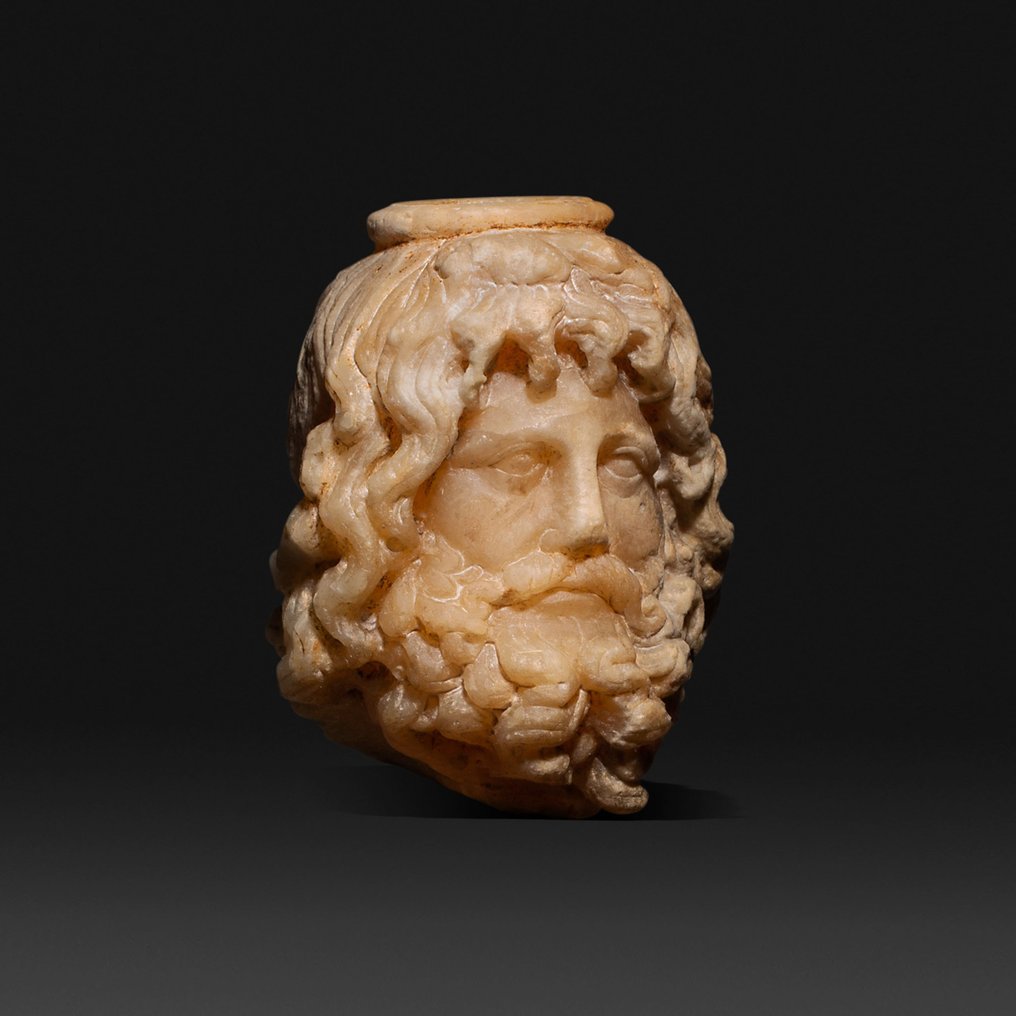
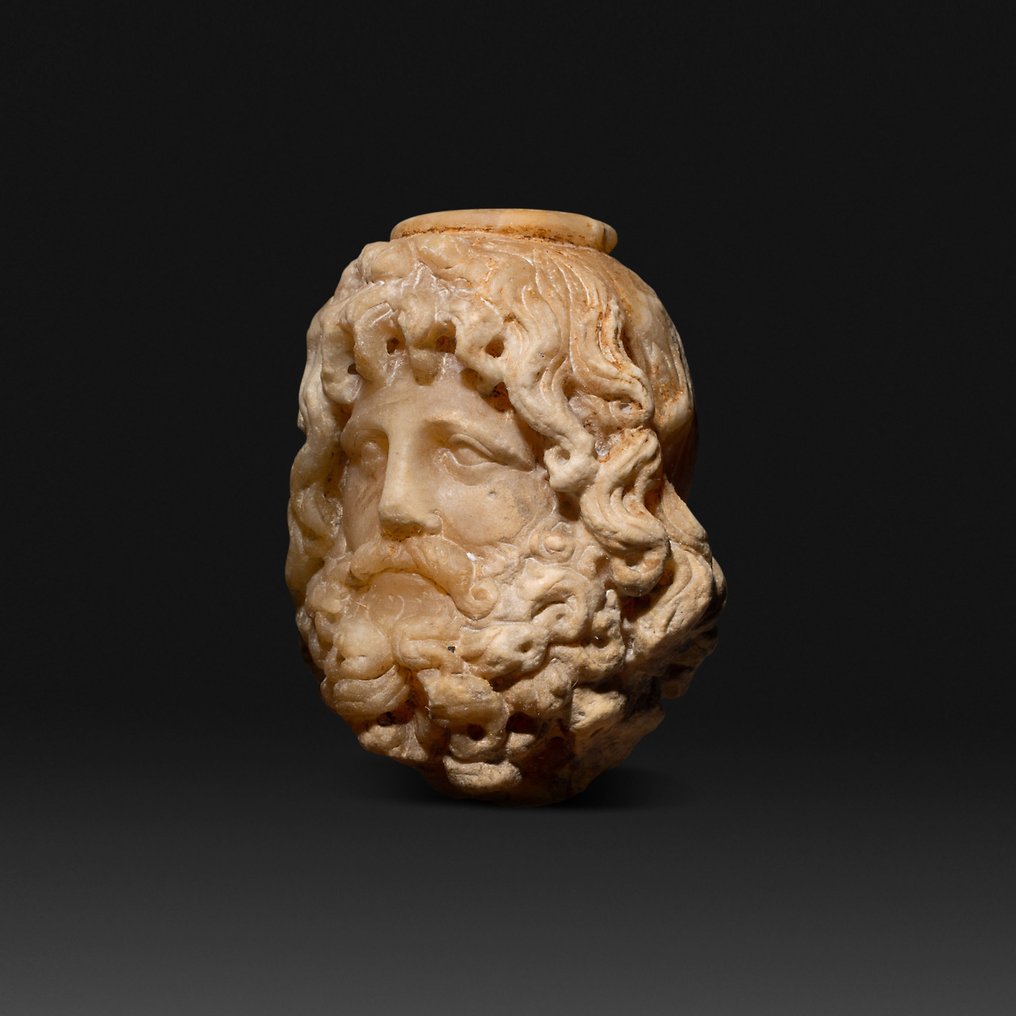
Serapis Head.
Roman
1st - 2nd century AD.
Alabaster.
Height 9.5 cm and 20 cm with the stand.
PROVENANCE: Private collection, France. Acquired by family inheritance. 1970.
CONDITION: In a good state of preservation.
DESCRIPTION:
A beautiful head that belonged to a bust or sculpture, sculpted in translucent alabaster, of the syncretic Egyptian-Roman deity Serapis. It was probably intended to be placed on a private altar or as decoration in a room of a Roman domus. Similar examples have been found in both Egypt and Rome, as well as in other cities on the Italian peninsula. Its sculptural style suggests that it may well have been made in Egypt.
This deity is depicted in its most common form: an adult male with long hair and beard. The essential attribute that distinguished the images of Serapis from those of other similar gods is the calathus or modius, the sacred basket of the mysteries, symbol of abundance, which would have been made piece by piece. It unites the concepts of agricultural fertility, life and death; it was used in the art of Ancient Egypt and in the Greco-Roman world. It resembles the bun that was worn on the head to carry something heavy. Its name was given by scholars because of its resemblance to the Roman modius, an utensil used as a unit of measurement for grain capacity.
Ptolemy I, the first Greek ruler of Egypt after the death of Alexander the Great, declared Serapis to be the patron saint of Alexandria and the official god of Egypt and Greece, thus linking the two peoples. Ptolemy's intention was probably to find a deity who would command the respect and veneration of the Hellenes and the intensely traditionalist Egyptians alike. It is unlikely that the Greeks would have accepted a zoocephalous deity, in the Egyptian manner, whereas the Egyptians would have been more willing to accept any aspect for this god. A typical Greek icon was therefore chosen, which was proclaimed to be the anthropomorphic equivalent of a much revered Egyptian divinity, the ox Apis, assimilated to Osiris. Serapis is thus a syncretic divinity in which cultic practices of different origins are synthesised in a new image.
Notes:
The piece includes authenticity certificate.
The piece includes Spanish Export License (Passport for European Union) - If the piece is destined outside the European Union a substitution of the export permit should be requested. This process could take between 1 and 2 months.
#masterpieces
Der Verkäufer stellt sich vor
Serapis Head.
Roman
1st - 2nd century AD.
Alabaster.
Height 9.5 cm and 20 cm with the stand.
PROVENANCE: Private collection, France. Acquired by family inheritance. 1970.
CONDITION: In a good state of preservation.
DESCRIPTION:
A beautiful head that belonged to a bust or sculpture, sculpted in translucent alabaster, of the syncretic Egyptian-Roman deity Serapis. It was probably intended to be placed on a private altar or as decoration in a room of a Roman domus. Similar examples have been found in both Egypt and Rome, as well as in other cities on the Italian peninsula. Its sculptural style suggests that it may well have been made in Egypt.
This deity is depicted in its most common form: an adult male with long hair and beard. The essential attribute that distinguished the images of Serapis from those of other similar gods is the calathus or modius, the sacred basket of the mysteries, symbol of abundance, which would have been made piece by piece. It unites the concepts of agricultural fertility, life and death; it was used in the art of Ancient Egypt and in the Greco-Roman world. It resembles the bun that was worn on the head to carry something heavy. Its name was given by scholars because of its resemblance to the Roman modius, an utensil used as a unit of measurement for grain capacity.
Ptolemy I, the first Greek ruler of Egypt after the death of Alexander the Great, declared Serapis to be the patron saint of Alexandria and the official god of Egypt and Greece, thus linking the two peoples. Ptolemy's intention was probably to find a deity who would command the respect and veneration of the Hellenes and the intensely traditionalist Egyptians alike. It is unlikely that the Greeks would have accepted a zoocephalous deity, in the Egyptian manner, whereas the Egyptians would have been more willing to accept any aspect for this god. A typical Greek icon was therefore chosen, which was proclaimed to be the anthropomorphic equivalent of a much revered Egyptian divinity, the ox Apis, assimilated to Osiris. Serapis is thus a syncretic divinity in which cultic practices of different origins are synthesised in a new image.
Notes:
The piece includes authenticity certificate.
The piece includes Spanish Export License (Passport for European Union) - If the piece is destined outside the European Union a substitution of the export permit should be requested. This process could take between 1 and 2 months.
#masterpieces
Der Verkäufer stellt sich vor
- 744
- 6
- 0
Prachtig schilderij. Zo blij mee. Zeer nette verkoper en zeer snelle levering.
Übersetzung ansehenperfect ! very fast and high quality delivery !
Übersetzung ansehenAll well! Thanks.
Übersetzung ansehenVendeur très professionnel, top +++×
Übersetzung ansehenPhotos trop contrastées pour bien percevoir les défauts, mais ces défauts étaient visibles pour autant. Le "Bon état" est trompeur. Sinon, envoi rapide et correctement emballé. Frais de port exagérés.
Übersetzung ansehenGreat communication, delivery and product. Came with a well made certificate of authenticity and good packaging. Overall very happy with the purchase! Delivery is a bit expensive, but I recommend it
Übersetzung ansehenMagnifique témoin du passé, envoyé avec tous les justificatifs, impeccable. Encore une fois très satisfait, un grand merci
Übersetzung ansehenThank you for the Special offer and the fast shipping of this excellent piece of art!
Übersetzung ansehenvery good description of the object, very good price for this rare item,. Fast sending (has been at my place 2 days after buying!). Definitely would buy again.
Übersetzung ansehenSehr schön
Übersetzung ansehenAs described, perfect logistic
Übersetzung ansehengreat seller, everything came as should with certificate of authenticity
Übersetzung ansehenExceptionally well packaged, description aligned with positing received
Übersetzung ansehenReally precious, but without sound...
Übersetzung ansehenPainting well packed and rapidly sent!
Übersetzung ansehensempre grande rapidità e professionalità
Übersetzung ansehenparfait bien reçu, merci
Übersetzung ansehenVery satisfied with the small Greek Lekythos. As always (we have already bought several items from Bagot), the object was wrapped and sent immediately and with the greatest care.
Übersetzung ansehenPerfect, excellent condition, good packaging, the parcel arrived without any problems… all is perfect as usual. Thank you very much and wait for an other nice piece like this one. Gilles.
Übersetzung ansehen+++ Top vendeur professionnel comme d'habitude
Übersetzung ansehenEmbora o custo de transporte esteja acima da média foi, realmente, muito bem executado e em embalagem cuidada. Expeditos e profissionais. Recomendo
Übersetzung ansehenSnel en correct en goed verpakt verzonden
Übersetzung ansehenoggetto bellissimo, fedele alla descrizione, venditore affidabile
Übersetzung ansehenVery nice piece and fast delivery
Übersetzung ansehen- 744
- 6
- 0
All OK and with very fast shipping.
Übersetzung ansehenDisclaimer
Der Verkäufer garantiert und kann belegen, dass das Objekt legal erworben wurde. Der Verkäufer wurde von Catawiki darüber informiert, dass er die Unterlagen, die gemäß den Gesetzen und Vorschriften seines Landes erforderlich sind, zur Verfügung stellen muss. Der Verkäufer garantiert, dass er berechtigt ist, das Objekt zu verkaufen/auszuführen. Der Verkäufer wird dem Käufer alle Informationen, die zur Provenienz des Objekts vorliegen, zur Verfügung stellen. Der Verkäufer versichert, dass alle erforderlichen Genehmigungen eingeholt wurden/werden. Der Verkäufer wird den Käufer unverzüglich über etwaige Verzögerungen bei der Einholung dieser Genehmigungen informieren.
Der Verkäufer garantiert und kann belegen, dass das Objekt legal erworben wurde. Der Verkäufer wurde von Catawiki darüber informiert, dass er die Unterlagen, die gemäß den Gesetzen und Vorschriften seines Landes erforderlich sind, zur Verfügung stellen muss. Der Verkäufer garantiert, dass er berechtigt ist, das Objekt zu verkaufen/auszuführen. Der Verkäufer wird dem Käufer alle Informationen, die zur Provenienz des Objekts vorliegen, zur Verfügung stellen. Der Verkäufer versichert, dass alle erforderlichen Genehmigungen eingeholt wurden/werden. Der Verkäufer wird den Käufer unverzüglich über etwaige Verzögerungen bei der Einholung dieser Genehmigungen informieren.


